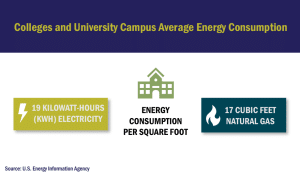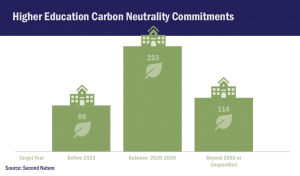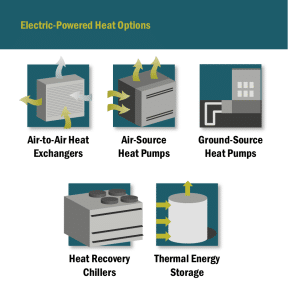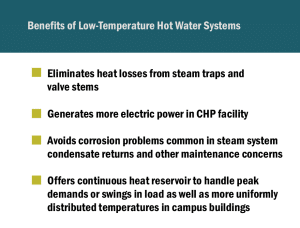Carbon Neutrality Will Reshape College Campuses
The decarbonization movement is reshaping higher-education facility operations. Amid warnings that the world needs to achieve carbon neutrality to avert the most catastrophic impacts of climate change, hundreds of colleges and universities are taking action.
Campus leaders who choose to undertake this challenge should prepare for a long and unpredictable journey. Each campus requires a customized decarbonization strategy, involving a transformation of conventional power sources, building systems, transportation options, and more. The transition will inevitably raise new financial, technical and operational challenges.
Electrification powered by renewable energy
With solar and wind power now scalable, affordable and abundant, the fastest route to carbon neutrality is through widespread electrification. Colleges and universities are abandoning gas- and oil-powered equipment — everything from cooking and laundry machines to larger energy uses such as space heating systems and shuttle buses — while switching to renewable energy and battery power wherever feasible.

With fossil fuels still generating 60 percent of U.S. electricity, campuses must first green their electricity supply. Many institutions now purchase electricity from producers who sell Renewable Energy Credits. During the 2018-2019 school year, more than 3,500 GWh was purchased by colleges and universities, accounting for more than a third of electricity demand for the 107 institutions reporting data to the U.S. Environmental Protection Agency.
To achieve 100-percent supply of zero-emission electricity, an increasing number of colleges and universities are partnering with developers to build renewable energy projects themselves, either on campus or on third-party sites. The University of Pennsylvania, for example, will source 75 percent of their electricity through a 220-MW solar power purchase agreement.

Renewable energy options still make up only a fraction of heating sources. District heating systems, a long-time staple of higher-education facilities, almost exclusively rely on fossil fuel-powered energy — mainly natural gas. As a result, heating systems are often responsible for the largest share of many institution’s greenhouse gas emissions, especially in colder climates.
Renewable sources are available, such as biogas from landfill methane, wastewater treatment plants, or animal manure. The current cost of biogas is, however, significantly higher than natural gas, and supplies are more limited. How to electrify heating supplies remains one of the largest decarbonization challenges.
The fastest route to carbon neutrality is through widespread electrification.
Options for carbon-neutral heating
Many colleges and universities rely on carbon-intensive district steam systems for space heating across campus buildings as well as for various laboratory devices, humidification systems, and washing appliances.
The infrastructure powering these systems will likely remain operational for many years to come, especially on campuses that recently upgraded to high-efficiency systems. About one-third of the 283 cogeneration plants currently found on college campuses came online in the last 10 years, according to U.S. Department of Energy data. Early retirement of a fully functioning system is likely an unworkable strategy.

Phased replacement with advanced heating technologies can instead allow campuses to gradually transition toward a zero-emission solution. One strategy could be to convert district heating systems to produce hot water instead of steam. Advantages include:
- Producing hot water requires less energy than generating steam.
- Hot water can be readily produced using electricity, scalable for large systems, and easily adjustable to meet demand.
- An electricity-powered hot water system, such as a geo-exchange heat pump, can rely entirely on renewable energy.
- Hot water can be stored for peak use, avoiding surges in electrical demand.
- Unlike steam boilers and central plants that require specially trained operators, hot water plants and systems can be managed by the institution’s internal facilities team.
For instance, American University in Washington, D.C. replaced a steam system that reached the end of its useful life with a Low-Temperature Hot Water System (LTHWS). Typical steam systems lose 50-70 percent of purchased energy when producing heat. American University anticipates heat loss of only 14 percent. The project is expected to cut campus-wide carbon emissions in half plus create maintenance and environmental safety benefits for facility staff.

New operational challenges
Electrification will lead to greater electrical demand.
Transitioning to electricity likely necessitates an expansion in electric power infrastructure. Whether produced remotely, onsite, or some combination of the two, campus electric distribution infrastructure, transformers, and switching equipment will have to be beefed up to accommodate new loads.
Absent strategies and systems to effectively manage peak loads, institutions may potentially be vulnerable to surges in energy prices as demand grows, depending on energy-provider arrangements, and susceptible to significant increases in peak-demand.
Electrification will raise resiliency concerns.
In the event of a disaster or other disruption to power supplies, new back-up power systems will be needed. Even then, power reliability will remain a concern if the transition to back-up generators or batteries creates short-term disruption. This is especially a concern for facilities operating sensitive laboratory or Information Technology equipment, where networks of uninterruptable power supplies (UPS) may need to be integrated into campus electrical systems.
Low-carbon heat will require higher-performance facilities.
District systems rely upon the high levels of heat transferred through steam to compensate for the poor insulation, leaky windows, and antiquated air-handling systems common across older campus buildings. For hot water to meet the heating needs of a campus, the transition may involve producing greater output of heat, resizing air-handling units, or improving the energy efficiency of building envelopes. In most situations, a hot-water system upgrade will require simultaneous building upgrades across campus.
Hybrid heating solutions will be needed in unique situations.
District heating systems are not connected to all buildings, and not all gas and steam devices connect to a central plant. Medical and research facilities, in particular, rely on local applications of steam, high-temperature water, or natural gas combustion. As a result, distributed heating systems may be needed to provide high-temperature heat for specific applications. Examples include clean-steam generators, library humidifiers, and autoclaves. Additional, lower-cost “peak” space heating and cooling systems may also be needed to augment base load systems during extreme temperature events.
Modular, scalable, future-proofed strategies
Long-term planning is essential to decarbonization success. In addition to careful consideration of capital and operational costs, carbon-neutrality roadmaps should factor in plans for system reliability, redundancy, scalability and flexibility.
Prepare for multiple decarbonization scenarios. Phasing strategies will need to remain adaptable, tied to other campus renovations, facility retrofits, technology advances and decisions on infrastructure replacements.
Whatever the chosen technology approach, decarbonization plans should be modular and scalable. Typical five-year capital planning budget cycles may need to be stretched out, given the projects’ scale and technical complexity.
If implemented effectively, financial and operational benefits can be tremendous. Large-scale transitions to electrification, on-site renewable energy, and battery storage systems can turn campuses into independent, self-sustaining, decentralized energy systems.
Achieving carbon neutrality will position colleges and universities as models for building a low-carbon future — a role befitting the ingenuity and innovation expected of our higher-education institutions.


